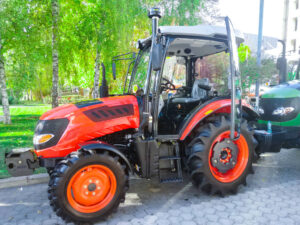Tractors are the workhorses of the agricultural industry, performing a wide range of tasks on farms and fields. One crucial component that directly impacts their performance and efficiency is tractor tires. These rugged, specialized tires play a vital role in providing traction, stability, and maneuverability on various terrains.

In this article, we will delve into the world of tractor tires, exploring their construction, types, key features, maintenance, and the importance of selecting the right tires for optimal agricultural operations.
- The Construction of Tractor Tires:
Tractor tires are designed to withstand heavy loads, challenging terrains, and demanding work environments. They are typically constructed using multiple layers of reinforced rubber and fabrics, providing strength, durability, and resistance to punctures and wear. The innermost layer, known as the inner tube, holds the air that provides the tire’s structure and support. Surrounding the inner tube is the carcass, made up of multiple layers of fabric, which provides strength and flexibility. The outermost layer, known as the tread, consists of specially designed patterns and grooves that provide traction and grip.
- Types of Tractor Tires:
a. Agricultural Tires: These are the most common type of tractor tires, designed for use in various agricultural applications. They come in different tread patterns, such as lug, bar, and ribbed, each suitable for specific tasks and terrains. Agricultural tires offer excellent traction and flotation, enabling tractors to navigate through muddy fields, uneven surfaces, and challenging conditions.
b. Industrial Tires: Industrial tires are designed for tractors used in non-agricultural applications, such as construction, material handling, and industrial operations. They are built to withstand heavy loads, provide stability, and offer increased resistance to punctures and damage from debris found in these environments.
c. All-Purpose Tires: These versatile tires are designed to handle a wide range of tasks and terrains. They offer a balance between agricultural and industrial tires, making them suitable for tractors used in both farming and non-agricultural applications.
d. Specialty Tires: Specialty tires are designed for specific tasks or terrains. For example, flotation tires are ideal for reducing soil compaction in delicate areas, while row-crop tires are designed for tractors used in row-crop farming, providing narrow tread patterns for precise spacing between rows.
- Key Features and Considerations:
When selecting tractor tires, several key features and considerations should be taken into account:
a. Tread Design: Different tread patterns offer varying levels of traction, self-cleaning capabilities, and resistance to slippage. The choice of tread pattern depends on the specific application and terrain.
b. Tire Size and Load Rating: Tractor tires come in a range of sizes and load ratings. It is essential to choose the appropriate size and load rating to ensure compatibility with the tractor’s weight and power requirements.
c. Tire Pressure: Proper tire pressure is crucial for optimal performance, efficiency, and tire longevity. Underinflated or overinflated tires can lead to reduced traction, increased fuel consumption, and premature tire wear.
d. Tire Maintenance: Regular maintenance, such as checking tire pressure, inspecting for damage or wear, and rotating tires, is essential for maximizing their lifespan and performance. Additionally, storing tires properly when not in use can help prevent degradation.
- The Importance of Choosing the Right Tractor Tires:
Selecting the right tractor tires is crucial for maximizing agricultural performance and efficiency. Here are a few reasons why it is essential to choose appropriate tires:
a. Enhanced Traction: Tractor tires with the right tread pattern and design provide superior traction, allowing tractors to operate effectively on various terrains.

Learn more at Wiki as well.